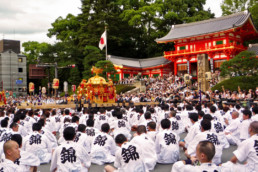Japan Travel: Yanaka Pilgrimage - Hidden Tokyo
Hidden Tokyo: pilgrimage in search of good fortune.

Photo credits: japaneseprints.livejournal.com
The relationship that Japan has with religion, and with spirituality in particular, is very peculiar. It is discrete, sometimes hidden, but it is an ever-present bond
made of everyday gestures and rituals. Sometimes, in particular occasions or in difficult moments, Japanese people pay a visit to this or that deity asking for protection and benevolence. Among the most revered deities in the whole country there are the 'Seven Gods of Fortune', in japanese Shichi Fukuji (七福神).It is therefore not unusual to find short pilgrimage routes in honor of these gods.
These seven deities arrived in Japan centuries ago and are the result of a slow process of assimilation. A process that saw Buddhism, Hinduism, Taoism and Shinto blend together. Walking through a fixed course reaching the temples of all the seven divinities, the pilgrim collects seven stamps or inscriptions to commemorate the visit.
These pilgrimages are more frequent during the first two weeks of the year. In fact, this is the period in which, according to ancient Japanese traditions, the seven deities land on the shore with their 'ship of treasures' distributing gifts and good fortune to everyone.
Only in Tokyo there are more than 20 such pilgrimage courses, and the one we want to talk about this time will take you on a journey of discovery through Yanaka.
Yanaka is a small pearl dating back to the Edo period, set among tall buildings, shopping streets and the famous Ueno park. Its ancient heart has been kept untouched, and is often the destination of many tourists who want to find in the great metropolis a taste of its past.
Pilgrimage through Yanaka

Photo credits: flickr.com - Patrick Kenawy
This path through Yanaka starts from Tabata station, easily recognizable because it is one of the stops on the Yamanote Line, which connects all the main touristic spots of the city with its circular route.
Your first stop will be the Tokakuji temple, a short walk from the station.
As this is the first temple of the pilgrimage, here you can buy the scroll representing the seven deities that will then be marked at each destination.
This temple houses Fukurokuji, a deity that, as the name suggests, is the god of wisdom, wealth and longevity. Often represented as a bald old man with a incredibly high forehead, he is accompanied by a crane and a turtle, both symbols of longevity. Sometimes a black deer is also present. His statue is placed in the garden at the back of the temple and is open to the public only at New Year’s.
Although the temple is dedicated to Fukurokuji, the first thing that will attract your attention at the entrance will be two Nio statues. These two statues stand guard at the temple also giving their protection to the sick who ask for their help. In fact it is believed that they have healing powers. If you suffer from some illness, buy the appropriate piece of red paper at the temple and attach it to the statue where you feel the pain. The deity will heal you.
Here, you can also buy a map of the walk, to make it easier for you to find the way.

Photo credits: flickr.com - realitycheck2002
The second stop is the Sei'un-ji temple, also known as Hanamidera. As the name suggests, the temple was, and still is today, a particularly suitable destination to see flowers blooming in spring. This is possible thanks to the cherry trees and the azaleas planted here in the 18th century. The temple is dedicated to the god Ebisu, the youngest of the seven, god of commerce and protector of fishermen and workers, but also of young children.
Just a few steps away, there is the third temple of the pilgrimage, the Shusei-in temple that hosts Hotei. This deity, also known as the laughing Buddha, is represented as a bald man, with a round belly and a good-natured smile, who is often surrounded by children. Hotei could be associated with our Santa Claus as he brings gifts that bestows especially to children.
The statue of Hotei in the Shusei-in temple is particularly beautiful. Stop to pray at it, but also to admire the painted murals that characterize the temple.

Photo credits: japantoday.com
A bit more difficult to find is the Choan-ji temple, your next stop.
Here finds his home Jurojin, deity of longevity. Because of the similarities they share even in they way they are represented, Jurojin is often identified with Fukurokuji. But here is also possible to find Itabi, statues erected to preserve the repose of the souls of the dead during the Kamakura (1185-1333) and Muromachi (1336-1573) period. The Choan-ji temple houses three of them dating back to this period.
After this temple, head to Yanaka Cemetery and your next destination will be the Tennoji temple. It will welcome you with a large statue of a seated Buddha dating back to the late 1600s placed at its entrance. But your main objective will be a small shrine on your right. Here is housed Bishamonte, the warrior god represented with a spear and a pagoda in his hands, symbols of his dual nature. He is the god of warriors who punishes the wicked, and the association with the peaceful preacher Buddha should not surprise you. Bishamonten, also known as Tamonten, is also the protector of the places where Buddha preaches.
The second to last stop of this pilgrimage is the Gokoku-in temple, home of the god Daikokuten, deity of wealth and crops, but also protector of the house and in particular of the kitchen. A particular note goes to a small stage in the courtyard in front of the temple used for representations in honor of the deity.
The last destination, perhaps the most beautiful one, will take you through the Ueno park to reach the Shinobazu pond and the Bentendo temple.
Benten is housed in this temple, goddess of the arts and music. This deity is said to be happier when surrounded by water, which is why the temple is near this pond, and her symbol is a lute. Benten is also the divinity of knowledge and wisdom so, those who wish to succeed at work or in an exam pay a visit to her.
Although the temple is just a modern reconstruction, it remains faithful to the original structure and is particularly recognizable thanks to its bright colors. Dominant are red, white and teal.
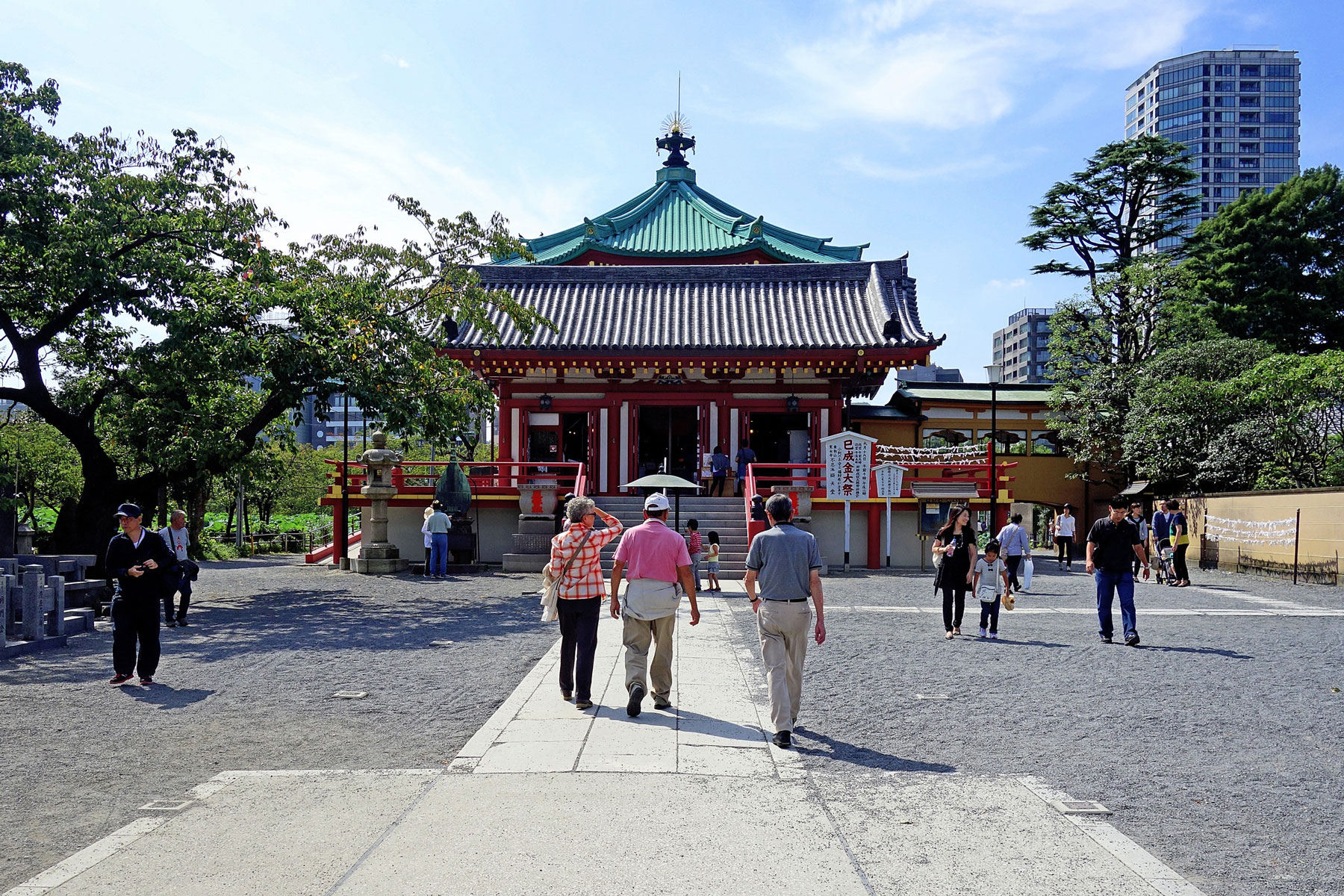
Photo credits: flickr.com - Toshihiro Gamo
Here the pilgrimage ends, but along the way there are plenty of distractions that will make your journey even more enjoyable.
Along the walk

Photo credits: Japan Italy Bridge
Along the way you will find a myriad of other small Buddhist and Shinto temples.
Take a stroll through the ancient district of Yanaka Ginza, just behind Nippori station, and stop to eat something at one of the many traditional kiosks in the area.
Just outside Yanaka you will find the small Kyooji temple where you can still see bullet holes on its central gate. These marks seem to date back to the battle of Ueno in 1868, during which the Imperial troops drove away from Edo the troops loyal to the shogun.
Yanaka cemetery will then give you a place to stop and rest. A place of peace that will surprise you even more during the cherry blossom.
And don’t forget the Ueno Park, a little ‘green jewel’ in the heart of Tokyo. A destination renowned for its wonderful cherry blossom and the famous Ueno Zoo with its pandas.

Photo credits: Japan Italy Bridge
In the park, among other temples, there is also the Toshogu shrine with its pagoda, that is dedicated to Tokugawa Ieyasu. Between April and May it will also be possible to enter the beautiful garden that houses a small but impressive peony collection, one of the most loved flowers in Japan.
There are also museums and traditional shops, on a journey to discover a Tokyo that is a little bit different from what we are used to, but certainly equally fascinating.
Japan Modern Culture: Kimi no Na wa - Your Name
Kimi no Na wa - Your Name

Photo credits: Tumblr.com
Your name (original title: 君の名は。- Kimi no Na wa.) is the popular Japanese animated film directed by Makoto Shinkai and produced by CoMix Wave Films. Between 2016, year of the release, and 2017 it has become a big box-office hit not only in Japan but all over the world.
The work has the traits of a teenage love story, but also that of a sci-fi thriller with references to Japanese traditions and culture. With continuous changes of perspective and time, a vivid and enveloping animation, a soundtrack that accompanies scenes and underlines every detail, Your name has won millions of fans over.
The Plot

Photo credits: www.zerochan.net
Focus of the story are two high school kids, Mitsuha Miyamizu and Taki Tachibana.
Mitsuha lives in the small mountain village of Itomori, near Tokyo, and loves spending her time with her two friends Sayaka and Tessie. She has a younger sister and a father, a local politician, who seems to care little for them. Their mother died and the two sisters live with their grandmother. Mitsuha, like her grandmother, is destined to become a Miko, a priestess of the local temple of which her family is the guardian. But this kind of life doesn’t suit her, as well as causing her a bit of embarrassment with her schoolmates. What she really wants is to move to the glittering metropolis and live like a normal girl, or better, be reborn as handsome boy from Tokyo.
Taki, on the other hand, lives right in the center of Tokyo and leads a normal life with his school duties, friends and his part-time job. In his free time he works as a waiter in an Italian restaurant, Il giardino delle parole (The garden of words), a name that is a clear reference to Shinkai’s previous work. He is a bit impulsive but still kind at heart, and hopes to become an architect in the future. Like the other male coworkers, he is in love with his beautiful colleague Miki Okudera.
One day, however, the life of the two protagonists, who live without knowing of each other's existence, is overturned by something unbelievable. In what seemed like a normal morning, the two find out they have switched their bodies without any plausible explanation. These exchanges will continue for some time so that, after the initial surprise, the two try to adapt to their new condition. Communicating mainly through a diary on their cell phones they will in a way help each other. Mitsuha, with her sweet and affable side, will help Taki to have a date with the colleague he is in love with. Taki, with his temperament, will help Mitsuha face his classmates and become more self-confident. It will not take long before they begin to feel something for each other, even though they have actually never met.
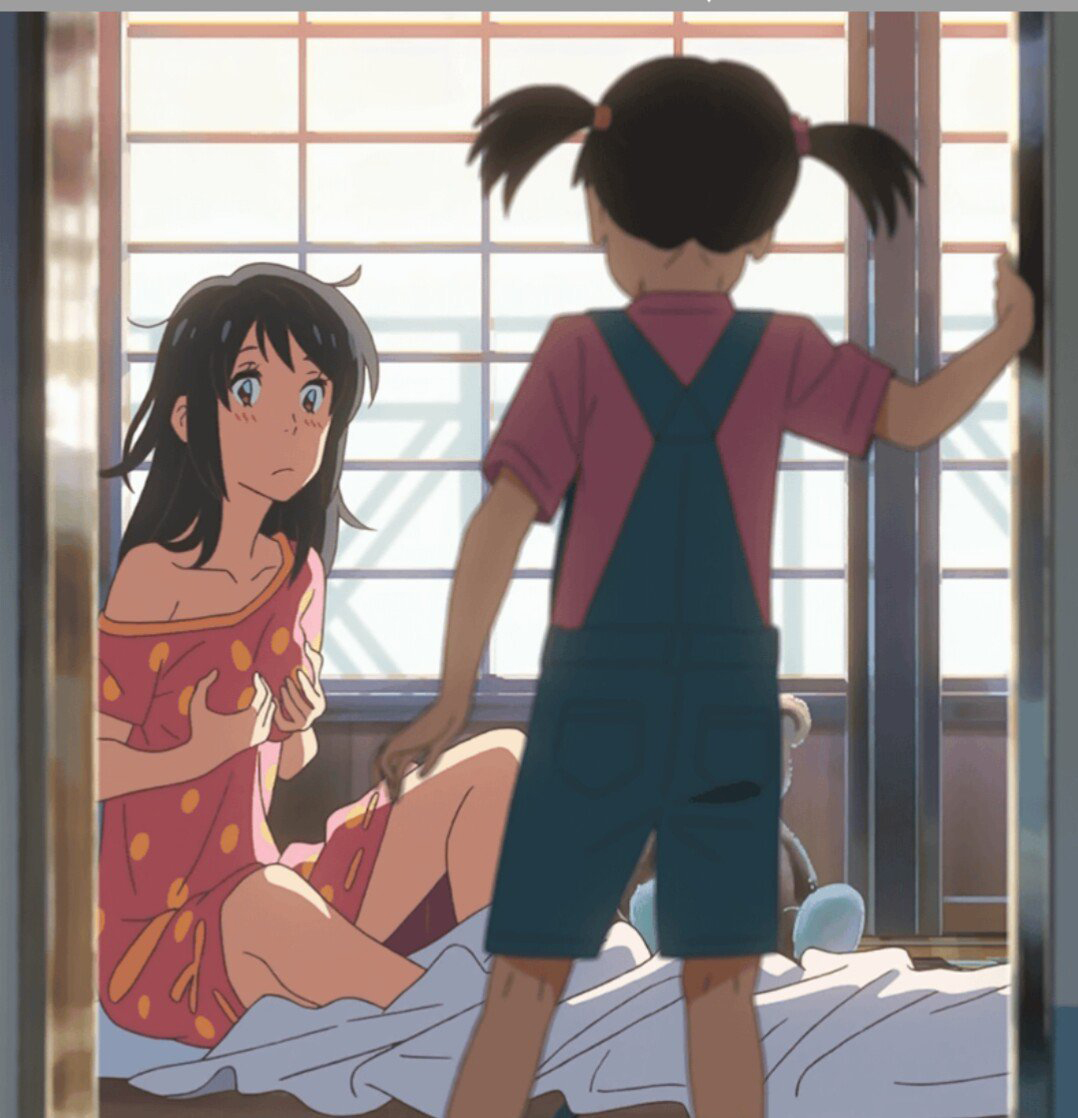
Photo credits: twitter.com
One day Mitsuha tells Taki about a comet that will pass by on the day of his date with the beautiful Okudera. At Itomori, that will be the day of the autumn festival. The boy does not understand what she's talking about but, when he tries to call Mitsuha on the phone for the first time, his attempt fails. He understands that for them it is no longer possible to switch bodies and so he decides to go and meet her in person. When he finally discovers the name of her village, he also finds out that it had been destroyed three years before. A fragment of the comet Tiamat had fallen on Itomori destroying the village almost completely and killing a third of the inhabitants, Mitsuha as well.
Taki then goes to the sanctuary of the local guardian god, Musubi, on top of Mount Hida just outside the village. After entering the holy place he decides to drink the Kuchikamizake, the sake prepared by Mitsuha and that he himself, with her body, had left there as an offer. This allows him to actually travel back in time. He sees Mitsuha's past and wakes up in the girl's body again, just before the comet's fall. Aware of what will soon happen Taki does everything to ensure that the inhabitants of the village recognise the danger themselves. But he also knows that this is his last chance to see Mitsuha. He runs to meet the girl at the top of Mount Hida, where his body of the future had been left. Here, the two protagonists can see each other, for a few moments, before their memories are erased. Their commitment saves the village thus changing the course of history, but at the same time leaves a sense of emptiness inside of theme. A hole left from something to which they can not give either a name or a face that urges them to look for each other, even if they have no recollection of what had happened.
The Success

Photo credits: one--anime.blogspot.it
The film, which premiered in July 2016 at the Anime Expo in Los Angeles, was then released in Japanese cinemas starting from August that year. Immediately acclaimed as a masterpiece, in its triumphal march it reached 92 countries, earning more than 355 million dollars. This makes it the 1st-highest-grossing-anime in history. A goal that even authors themselves did not expect to reach.
This commercial success made it the 2nd-highest-grossing film of all time in Japan after Hayao Miyazaki's Spirited Away. It also is 4th-highest-grossing film after Titanic and Frozen. But it has also earned the position of most watched Japanese anime in several other countries of the world.
As for Italy, the first Italian trailer was released only on December 6, 2016. Subsequently, the film was screened in about 160 theaters from 23 to 25, January 2017 thanks to a collaboration between Dynit and Nexo Digital. The success at the box-office was so great that several other dates were decided, with a total income of around 700,000 euros.
Looking at these numbers, it’s no surprise that director Shinkai has been sometimes referred to as Hayao Miyazaki’s successor. Title that the person himself has humbly refused saying he does not deserve it.
Themes and Symbolism
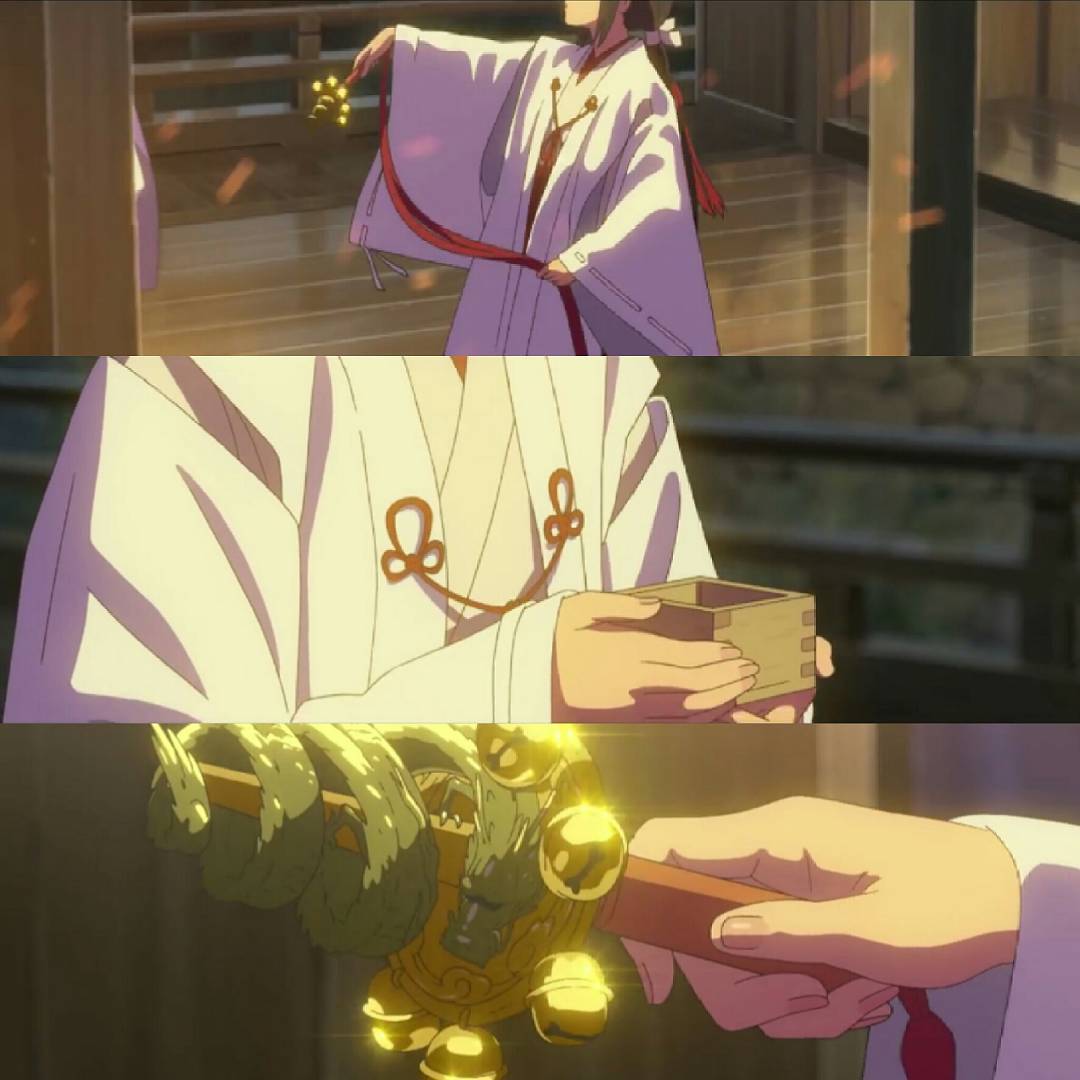
Photo credits: instarix.com
The inspiration for the story came to the author from works such as Inside Mari by Shūzō Oshimi or Ranma ½, as well as from classical works such as the Torikaebaya Monogatari dating back to the Heian period (794-1185). But another source of inspiration for the author seems to have been an ancient poem by the poet Ono no Komachi, who lived between 800 and 900. In one of her poems the woman wrote: "Before I slept I thought of him, and into the dream he strayed. Had I known it was a dream, in the dream I would have stayed."
And in fact, rather than swapping, the two protagonists of Your Name dream of each other. This is possible because Mitsuha is a priestess devoted to the God Musubi, the deity that governs experiences and human connections. When Taki, in Mitsuha's body, reveals himself to her grandmother, the old woman does not seem so surprised. Indeed, she herself had experienced the same thing, being it a particular family power, even though she no longer remembered the boy in her dreams.
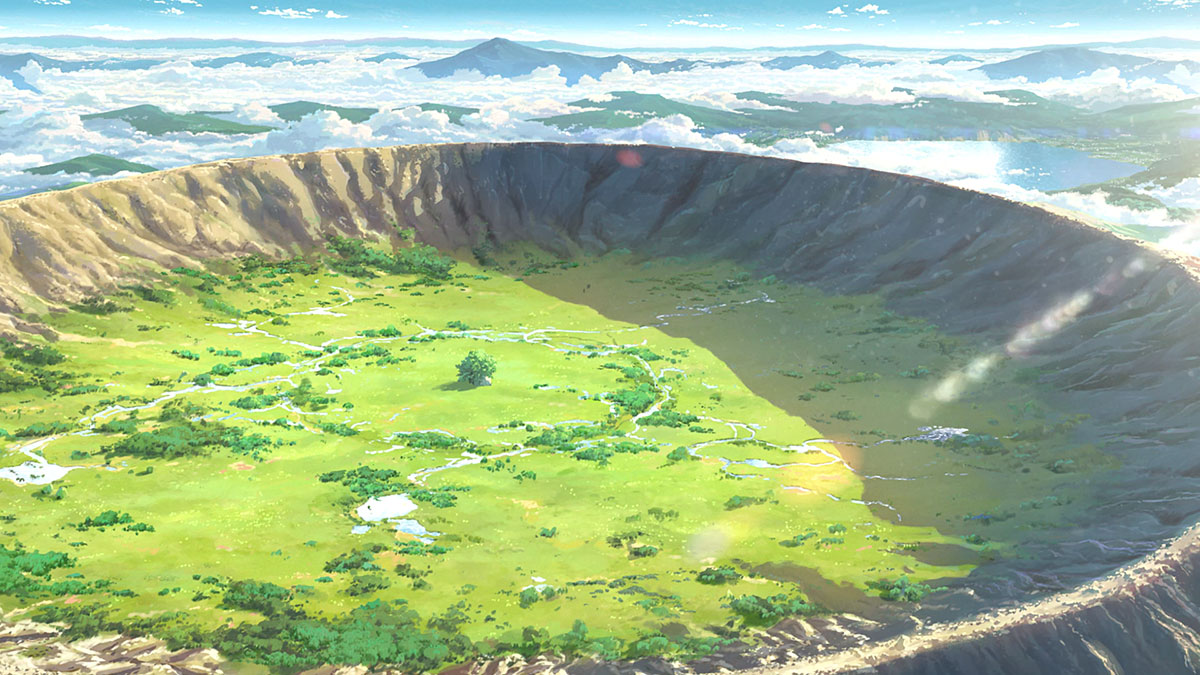
Photo credits: forum.gamer.com.tw
Located at the top of a mountain that appears to be the crater caused by a previous appearance of the comet, the temple is a sacred place. It represents the boundary between the kingdom of Gods and Earth, between the realm of the living and that of the dead. To return to the mortal world you have to leave a part of yourself, and Mitsuha left a part of herself in the sake she prepared. The creation of the Kuchikamizake is a family tradition, along with traditional dances and braiding threads. It is a particular method of creating sake which involves chewing rice to activate its fermentation.
In this regard, Mitsuha grandmother’s words are very important:
“Musubi is the old way of calling the local guardian kami.
Tying thread is Musubi. Connecting people is Musubi.
These are all the kami’s power.
So the braided cords that we make are the kami’s art and represent the flow of time itself.
They converge and take shape. They twist, tangle, sometimes unravel, break, then connect again.
Musubi-knotting. That’s time.
Musubi is also sharing something with others”
These words not only represent a very profound spiritual concept, but also make us understand the power of Taki’s gesture when he drinks the sake prepared by Mitsuha. In fact, this gesture is a symbolic act of profound connection in which the young man assumes in himself a part of Mitsuha and of her spiritual power, allowing him to meet her as well.

Photo credits: fakemorisummer.wordpress.com
Equally symbolic is the fact that the two of them meet at sunset. In fact, according to ancient legends sunset is the moment when the boundary between the world of the spirits and the world of the humans fades for a short moment. And that's why they can finally meet, even though Mitsuha had died 3 years before. The two, however, have to sacrifice their memories in order to return to the earthly world.
Another Japanese legend finds its space in the story. Taki and Mitsuha seem to be linked by what many know as the 'red thread of fate’ that is said to tie two people destined to be together. Red thread that, in this case, is symbolized a thread that Mitsuha herself had made and then gave to Taki.
Shinkai, who as we said before did not expect the worldwide success it had in terms of audience, said that it was his intention to create a film that targeted Japanese youth. He wanted to create something that would push them to believe in their future.
He said: "I created this movie hoping that younger audiences would believe that ‘maybe there is the one in my life I might have not met yet but hopefully will see tomorrow or in the future.’ "

Photo credits: www.amazon.co.jp
Another important issue addressed by the film is the juxtaposition between the small rural village and the great metropolis of Tokyo, something that the author himself has experienced. In fact, he grew up in a small village and later moved to Tokyo, which is common to many young Japanese people.
Here we see Mitsuha, she lives immersed in local traditions but yearns for the city life; and we see Taki, immersed in city life, that learns to appreciate the past and traditions.
Once again, it is the grandmother's words that help us: "Even if the words have been lost, it is important to preserve these traditions". With this, it looks like she want us to remember where we come from, in opposition to her son, a corrupt local politician who chose to abandon the temple completely.
Ancient traditions represent the founding substratum of a community, what the present is based on and which binds people together. And also what enables them to face even the darkest times.
Japan is no stranger to natural disasters, just remember the recent earthquake in 2011, or the great Kanto earthquake in 1923. And how to forget the atomic disaster that put an end to Second World War. In all these occasions Japan has always found the way to start anew, placing one interest over the others: what can we do to prevent this from happening again. No wonder then that in this film the two protagonists try to prevent what would have been a real tragedy.
The goal of the film is to give hope, but also invites us to never forget our roots and the spiritual union that they can create.
We could therefore say that Your name has a cathartic function for the viewer.
Strong Points

Photo credits: Lovejude
Whether you are among those who liked the film or not, Your Name certainly has several objective strong points.
First of all, the animation and the extremely realistic render of setting, as it is in the style of the author after all. The film’s landscapes are described in every detail and the colors are warm and bright. The images are so vivid that are able to convey, even with their colors only, the intense and pure emotions of the protagonists, thus contributing to the cathartic function of the film.
Also worthy of mention is the soundtrack that was composed by the vocalist of the Japanese rock band Radwimps, Yojiro Noda.
Noda, specially requested by Shinkai himself, had only one request to respond to :
“make it in a way that the music will (supplement) the dialogue or monologue of the characters".
And considering the results we can say that this soundtrack is one of the keys to the success of the film..
This world seems like it still wants to keep me tamed
As you wish, then- I'll struggle beautifully.
Your Name Theme song - Yojiro Noda
Yet despite the positive critics, Shinkai claimed that the film is actually not as good as he had thought. The lack of time and funds forced him to deliver to the public a work that he himself calls incomplete. He stated : "There are things we could not do, Masashi Ando [Director of animation] wanted to keep working [on] but we had to stop for lack of money ... For me it’s incomplete, unbalanced. The plot is fine but the film is not at all perfect. Two years were not enough."
Related Products and Remake

Photo credits: Amazon.co.jp
In addition to the film, products related to Your Name include other works, such as a novel, manga, film guides and CDs. In December 2016 alone, the sales of these products amounted to around 2.5 million copies.
The novel and manga of the same name are published in Italy by the J-Pop publishing. The Blu-ray and normal DVD versions, released in July 2016, arrived in Italy in November 2017.
Sales confirmed the success in cinemas.
Last September it was also announced that Kimi no na wa will soon have a Hollywood live action adaptation.
The chosen producer is none other than J.J. Abrams (Star Trek, Mission impossible). The announcement has already triggered the reaction of many people, both fans of the film and those who are simply curious. There are many voices worried that this adaptation could overturn what is considered a masterpiece.
And records do not seem to play in favor of this live action. It is still recent news that the director of Death Note's Netflix remake had to close his Twitter account after being strongly attacked for his work. Attacks that did not spare another adaptation of the popular anime Ghost in the shell, whose film with Scarlett Johansson did not really satisfy its fans.
Kimi no na wa is certainly not a easy film to adapt in a western setting because of its numerous references to particular places and particular cultural and religious concepts. Think of Mitsuha and her family, guardians of the shrine of the deity Musubi and the ancient traditions of the village.
As for the places, in addition to Itomori which is a fantasy village, there are real cities. Not only Tokyo, but also Hida, and the Itomori Lake itself is inspired by a famous Japanese lake, Lake Suwa.
Only time will tell us what the future of this adaptation will be.
Trailer:
Japanese Tradition: Gion Matsuri
Gion Matsuri: an unique experience
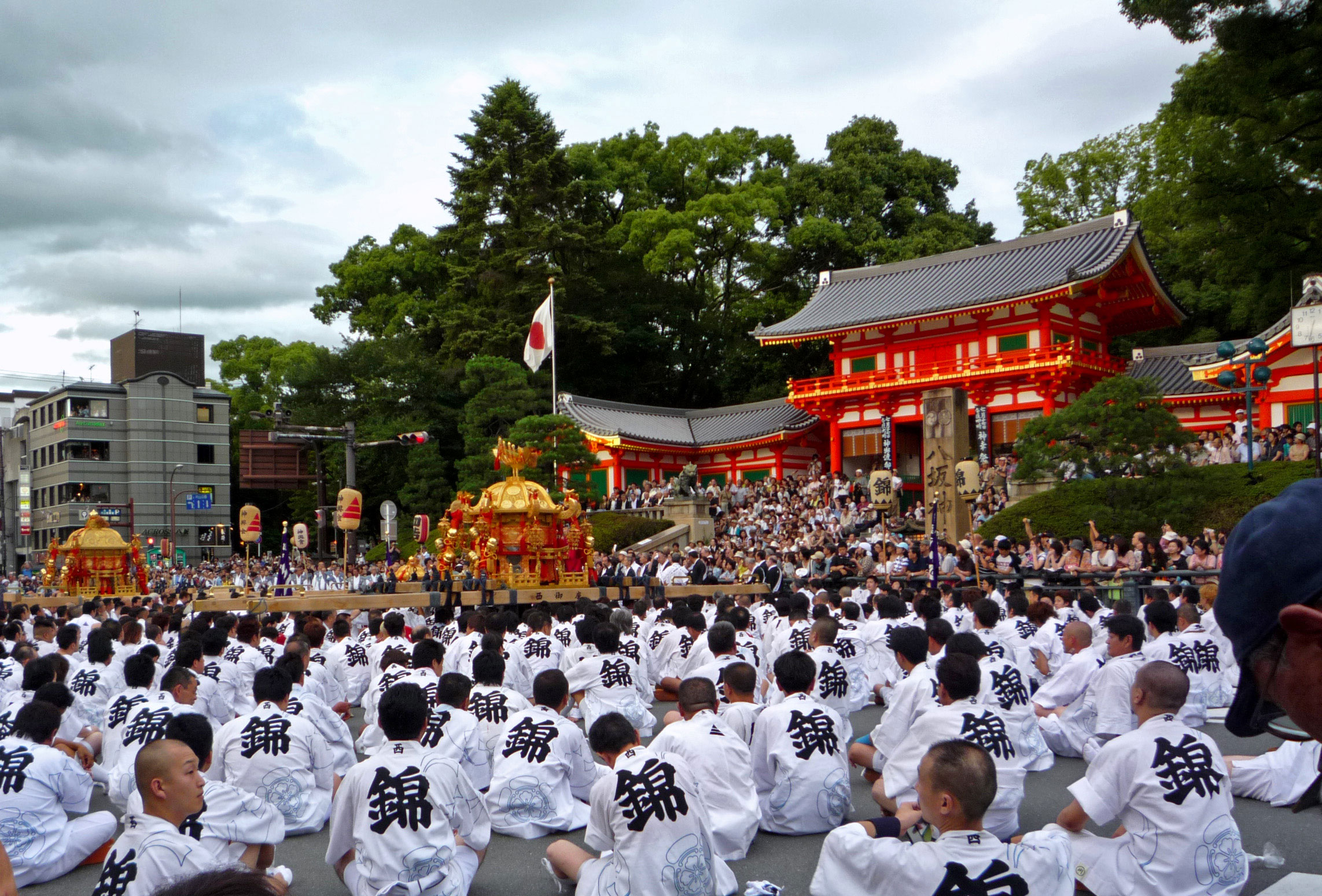
photo credit: Daranice
The Gion Festival or Gion Matsuri (祗園祭), this is how it has been called since the Meiji era, takes its name from the famous Kyōto area, Gion, Higashiyama district. It’s a religious celebration dedicated to the Susanoo God, also known as Takehaya Susanoo-no-Mikoto, worshiped in the Yasaka shrine.
Susanoo, God of the sea and storms, it’s also the God of the dead, as well as Amaterasu’s brother, from whom the Japanese Emperor’s family line is believe do descend.
Together with the Aoi Matsuri (May 15th) and the Jidai Matsuri (October 22nd), the Gion Matsuri is one of the three biggest religious festivals in Kyōto, and Japan as well. It is held every summer for the whole month of July. It is meant to calm the spirits of the dead and ask for protection over the city to the God so that he can keep illnesses and natural disasters away.
As you can imagine it’s a matsuri full of events. The most important and attractive are the Yamaboko Junkō ( 山鉾巡行, float’s parade) and the Mikoshi Togyo (神輿渡御, parade of the devine palanquins). Both this events are held between July 17th and 24th, when the festival reaches its climax.
One of the main reasons for the spectacularity of this festival is surely the size of the floats, especially the ones called Hoko. They can even be 25 meters high with a weight of over 10 tons that can move thanks to wheels about 2 meters of diameter. Every float is rebuilt every year from scratch, and then destroyed at the end of every festival. All the pieces are held together without the use of screws, as tradition wants.
But let’s move ahead with order...
A little bit of history

photo credit: kyotodeasobo.com
Tradition says that Gion Matsuri was born in 869. Since a century or so, the Imperial court had moved from Nara to Heiya-kyō (today’s Kyōto) and it was dominated by the Fujiwara family.
It is said that during a plague, the Imperial court decided to hold the first goryōe (御霊会), a purification ritual in the small Shinsen'en shrine. You need to know that at the time the city was situated in a very swampy area, very hot and humid. High concentration of people together with the absence of a proper drainage system made it easy for waste waters to contaminate clean waters. It’s not difficult to imagine that illnesses like malaria, smallpox, flu and dysentery became widely present. However, in ancient Japan the cause of all this was said to be something else entirely.
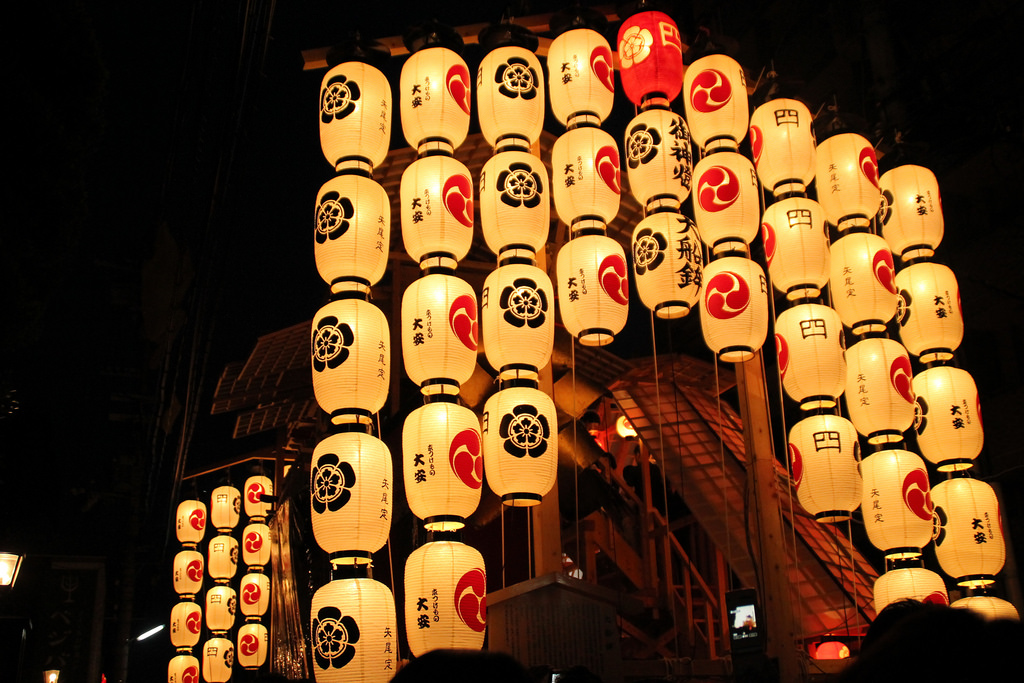
photo credit: japancheapo.com
According to the prediction of a master priest, the real cause of the plagues were devious spirits, identified in the ghosts of prince Sawara Shinnō and his companions. They, accused of the murder of the noble Fujiwara no Tanetsugu, died professing their innocence till the last moments.
The first goryōe was held while trying to calm the spirit by invoking the Susanoo God. Furthermore, the noble Urabe Hiramaru raised 66 spears, one for each Japanese region, so to enclose the evil spirits inside and purify the capital.
It was here that the custom of bringing three mikoshis, or divine palanquins, into procession was born, and it was also decided that a goryōe had to be head every time that a plague or illness was spreading.
Everything was accompanied by other celebrations and joyful moments.
Until 970, when it was decided that the Gion Goryōe (祗園御霊会) had to be held every year.
Afterward, starting from the Muromachi period, the event was enriched with the typical floats, the yamaboko (山鉾), also parading along the streets of the city. These were built thanks to the collaboration of the merchant class that in this very period lives a moment of success after centuries of denigration. Floats were adorned with decorations that became richer and more sophisticated year after year.
In other words, the parade also became a way to show off the richness of the merchant class.
In spite of some small interruptions (during the Ōnin war (1467-1477) and during World War II (1941-1945) ), the festival still lives today and can be proud of more than a thousand years of history.
Celebrations
Celebrations that,as we said, go on for the whole month of July, involve all the different areas of the city.
It kicks off on July 1st, where a ceremony called Kippuiri (吉符入) is held at the Yasaka shrine, Here, representatives of all the districts of the city in charge of the organization of the festival pray so that the it can proceed smoothly and with no incidents.
On July 2nd, at the Town Hall of Kyōto, takes place a lottery headed by the mayor of the city, through which the order of the floats for the parade is decided. Still, opening the procession is always duty of the Naginataboko (長刀鉾).

photo credit: heterophyllum
On July 10th, starts the preparation of the mikoshi (神輿), three palanquins that will house three small shrines dedicated to Susanoo. At the same time, a few buckets are immersed from the Shijō bridge into the sacred waters of Kamo river to draw the water that will be used to wash the mikoshi. In the late afternoon there’s also a parade with the exhibition of paper lanterns of traditional manufacturing that will be used to receive the God.
Also on the 10th, starts the building of the floats and walking along central streets of Kyōto you’ll be able to see theme slowly taking shape by the hands of their wise builders.
The days between the 14th and the 16th are those immediately preceding the main celebration. July 14th is known as yoi-yoi-yoi-yama (宵々々山), the 15th as yoi-yoi-yama (宵々山) while the 16th is called yoi-yama (宵山). The same goes for July the 21st,22nd e 23rd. During this days, starting from 6:00 p.m, the streets closed to traffic overflow with visitors and tourists voices. Here you can walk around vending stands, under the light of the paper lanterns always kept alive, admiring the yamabokos.
And it is also in this days that ancient families of the town open up their window so that people passing by can admire ancient treasures guarded for generations.
On July 15th, the imitaketate (斎竹建) and the yoimiya-sai (宵宮祭) are held. The first one is a ritual during which bamboo truncks are put together in square shape to delimit the area of the procession and protect it from contamination. On the other hand the yoimiya-sai is held at Yasaka shrine, and durig this ritual the spirit of the god is transferred into the 3 portable mikoshi that have already been purified.
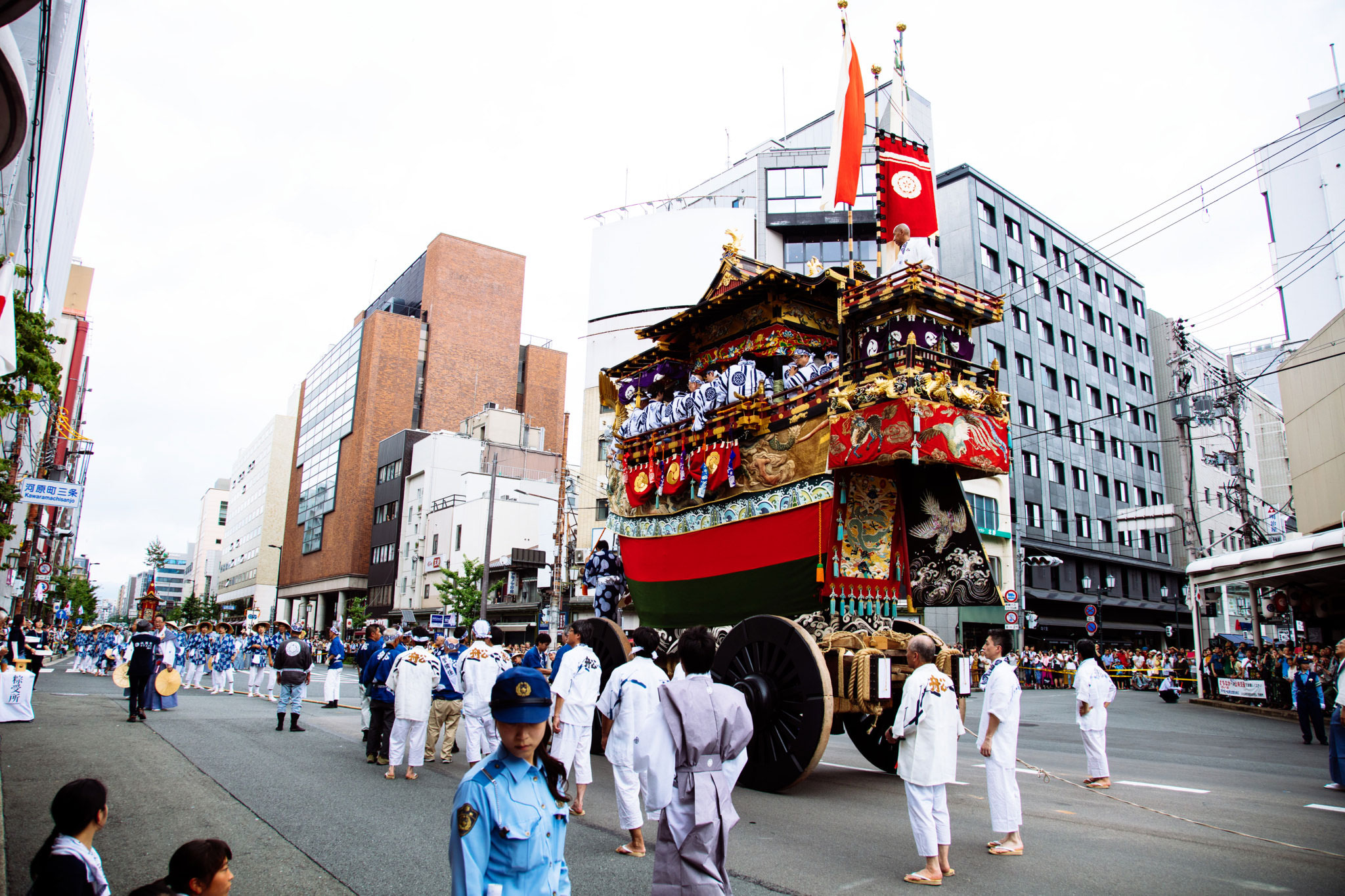
photo credit: Tomomi Onishi
In July 16th the musicians from all the floats go to the temple to pry for good weather the following day, and all is accompanied with music and dancing events along the way.
July 17th is the long awaited day in which the festival reaches its climax. It is the moment of the Yamaboko Junkō, the great floats parade. Floats are divided into 2 groups, yama 山 (mountain) and hoko 鉾 (spear). The opening group it that of the 9 hoko floats, and they symbolize the 66 spears used by Urabe Hiramaru to drive away the evil spirits. The second group is that of the 23 yama floats, smaller than the hokos, that carry life-size representations of important and famous personalities.
Every hoko carries musicians that accompanying the procession with their music.
Kon-kon chiki-chin, kon-kon chiki-chin… This is the distinctive sound of the Gion Matsuri, a traditional rhythm dating back to the Edo period.
And along the parade a profusion of many different dancers and acrobats make it even more joyful and lively. Obviously each and every one of them is dressed in colorful and rigorously traditional clothes.
Has said before the parade is lead by the Naginata-boko, called after the naginata (typical Japanese spear) that springs up from its top, and that is said to have the power to drive away evil spirits and plagues. The original Heian naginata had been forged in metal, but the one we can admire today is made of bamboo.
It is on the Naginataboko that a chigo (稚児) is carried, a young child dressed up in rich, traditional clothes with a golden phoenix-shaped headgear. This child has the duty to represent the God during the festival.
The chosen one, usually selected from the most powerful and important merchant and commercial families of the town, has to undergo a long preparation period before he is allowed to take on this role. Weeks of purification rites and complete isolation, away from everything that could contaminate him, including women. He is not even allowed to walk on common ground but he is carried by men in charge of this duty.
He will have the duty to cut with a single blow a big sacred thatch rope. This is the Shimenawa-kiri (しめ縄切り), an act through which the divinity enters the human world severing the limit that devised the two worlds, and with this act the great celebration can officially starts.
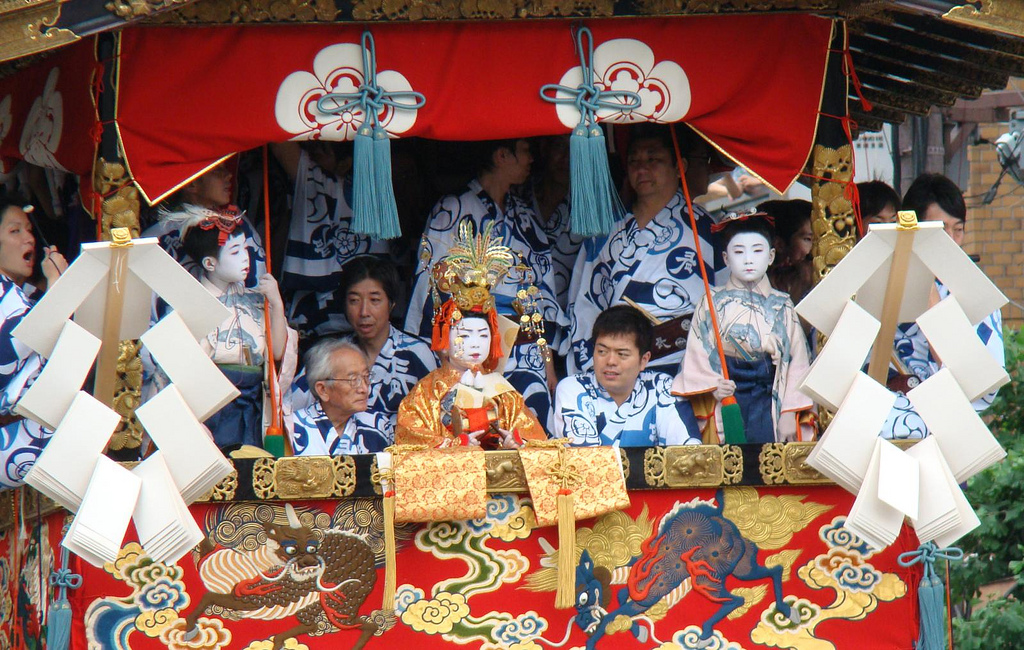
photo credit: picssr.com
In the late afternoon, takes place the mikoshi togyo, where the three mikoshis leave the temple. It is the long awaited Shinkō-sai (神幸祭), or the emerging of the divinity from the temple with its palanquins carried on shoulders around the streets of the city.
On July 24th this double procession is repeated and in the evening the three mikoshis are brought back to their temple. This is the moment of the Kankō-sai (還幸祭), through which the spirit of the God finally returns to the world he belongs to.
At the end of the parade the floats are immediately dismantled and all pieces kept until the next festival.
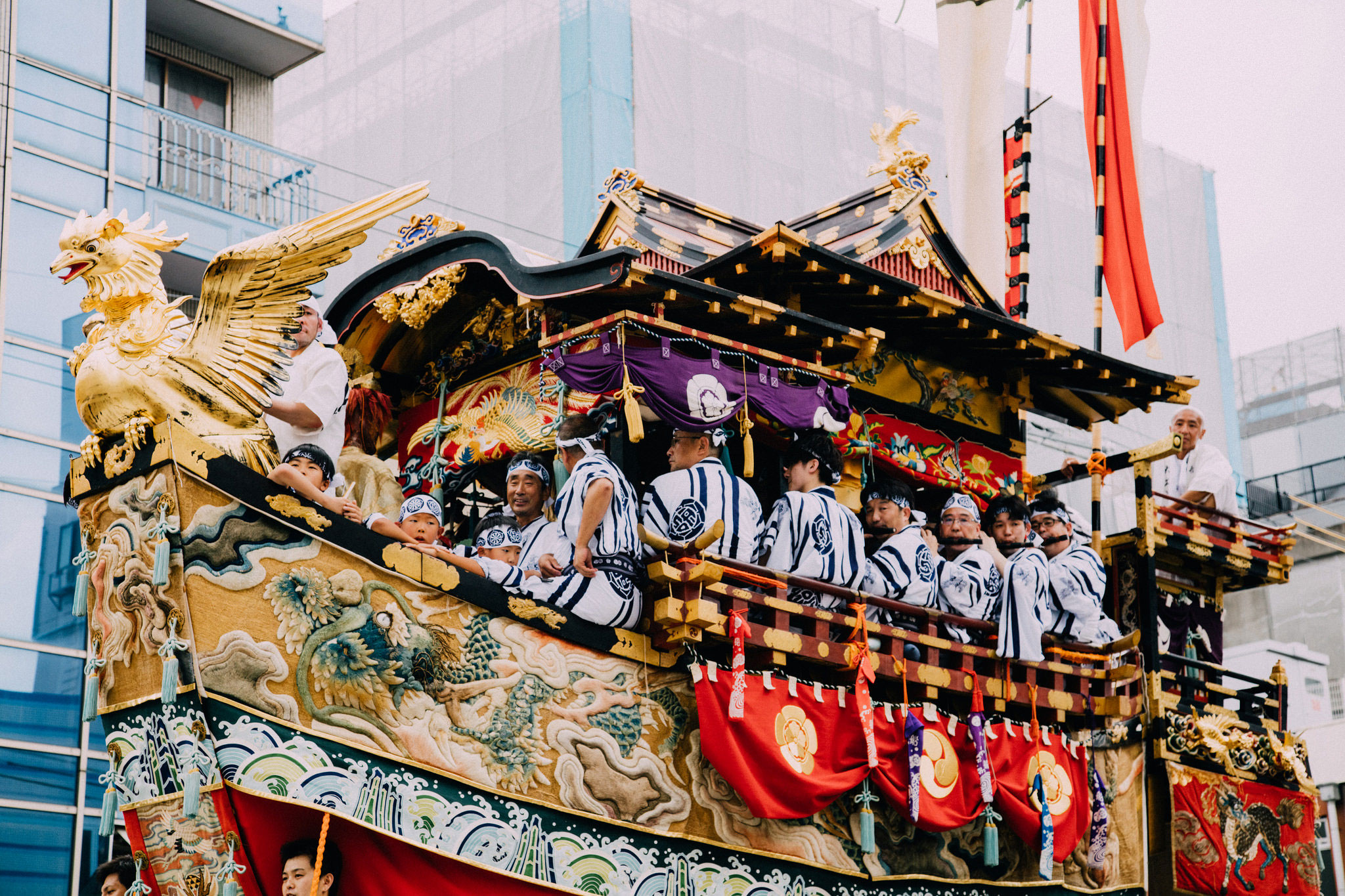
photo credit: Tomomi Onishi
On the same day takes also place the Hanagasa Junkō (花傘巡行), an event that, as suggested from the name, has flowers as its protagonist. In fact, it is written with the kanjis of hana (花) or flower, and kasa (傘) or umbrella. During the parade, the floats and all participants parading along the streets are all decorated with umbrellas and hats embellished with flowers.
The parade is opened by small mikoshis carried by young children, then follows a large parade of people in traditional clothes. There are representatives of social and cultural associations, musicians, dancers, acrobats and in particular some of the most famous geishas and maikos of the town. And they surely are the loveliest flowers displayed the event.
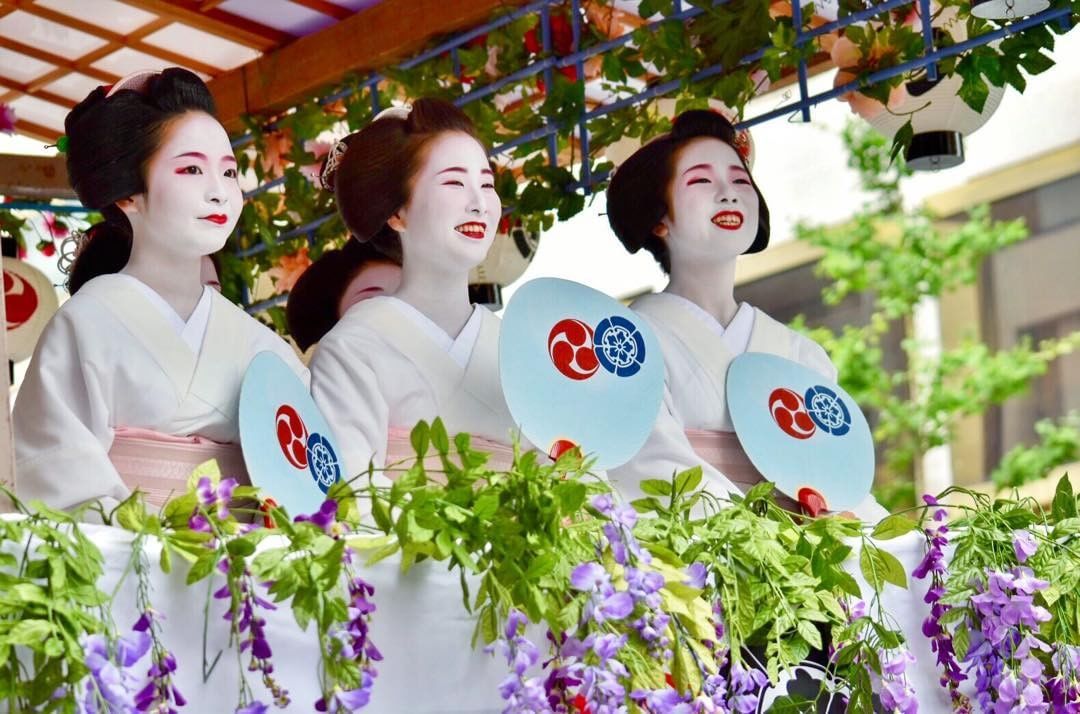
photo credit: geimei.tumblr.com
On July the 28, takes place the ceremony of the mikoshi-arai (神輿洗式),or the ritual of washing the mikoshis at Yasaka shrine, to purify the three palanquins, till next year.
If you are around don’t miss this moments. In fact, it is said that being hit by little splash of the water dedicated to the god brings good luck..
To mark the end of the Gion Matsuri there is the nagoshisai (夏越祭) festival, that is held every July 31st at Ekijin shrine.
Tied to the tori, the entrance gate that marks the beginning of the sacred area of the temple, there is a big thatch rope in the shape of a circle with 2 meters in diameter. It is the Chinowa (茅の輪).
Please do pass through it to be purified, and then you’ll receive a protection charm on with there’s written “Somin-shorai shison nari(蘇民将来子孫也) that means “I’m Somin Shorai’s descendant”. According to the legend, Somin Shorai was a simple man that one day happened to give hospitality to a traveler that had already been refused by a rich man. The traveler then reveals himself as a God and to thank him for his hospitality teaches him how to make lucky charms. Since then it is believed that this charms can push away catastrophe and thieves.
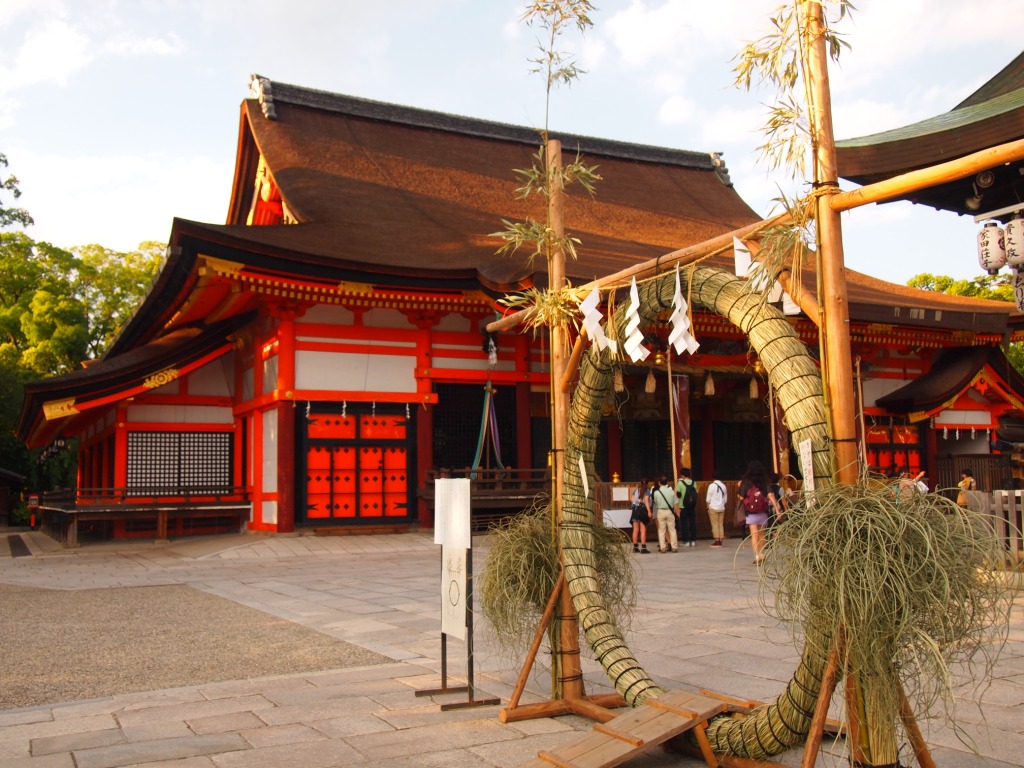
photo credit: kyoto-tabiya.com
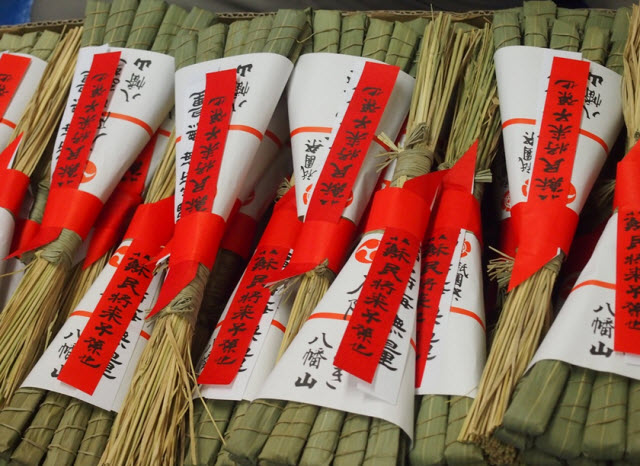
photo credit: kyotoiju.com
That of the Gion Matsuri in a long trip in which History and legend, religion and entertainment are entwined together. It is real a one-of-a-kind event.
And you? Have you ever been able to take part to it? We are waiting for your comments and experiences!
Japanese Culture: Shingeki no Kyojin
SHINGEKI NO KYOJIN – The revelation of the past few years
This time we will talk about Shingeki no Kyoujin (進撃の巨人), translated in English as Attack on Titans, the revelation of this past few years.
It's an action horror shōnen manga series already recognised as a cult among anime and manga fans. For those who don't know it, it is enough to know that in just a short period of time it was able to climb up all charts, Japanese ones and worldwide too. It became one of the most viewed anime around the world, and its original manga ranks second in numbers of sold copies, second only to One Piece.
To give you some numbers, we talk about around 2 million copies per volume (Japanese sales), while One Piece sales are around 3 million copies.
This results are even more incredible if we consider that One Piece has many years of releases already (the first volume was released back in August 1997). On the contrary, the first volume of Shingeki no Kyojin was release only in September 2009. This numbers are enough to make your head spin, and contributed to let this manga gain the prestigious Kodansha Manga Award in the shōnen category in 2011, to say the least.
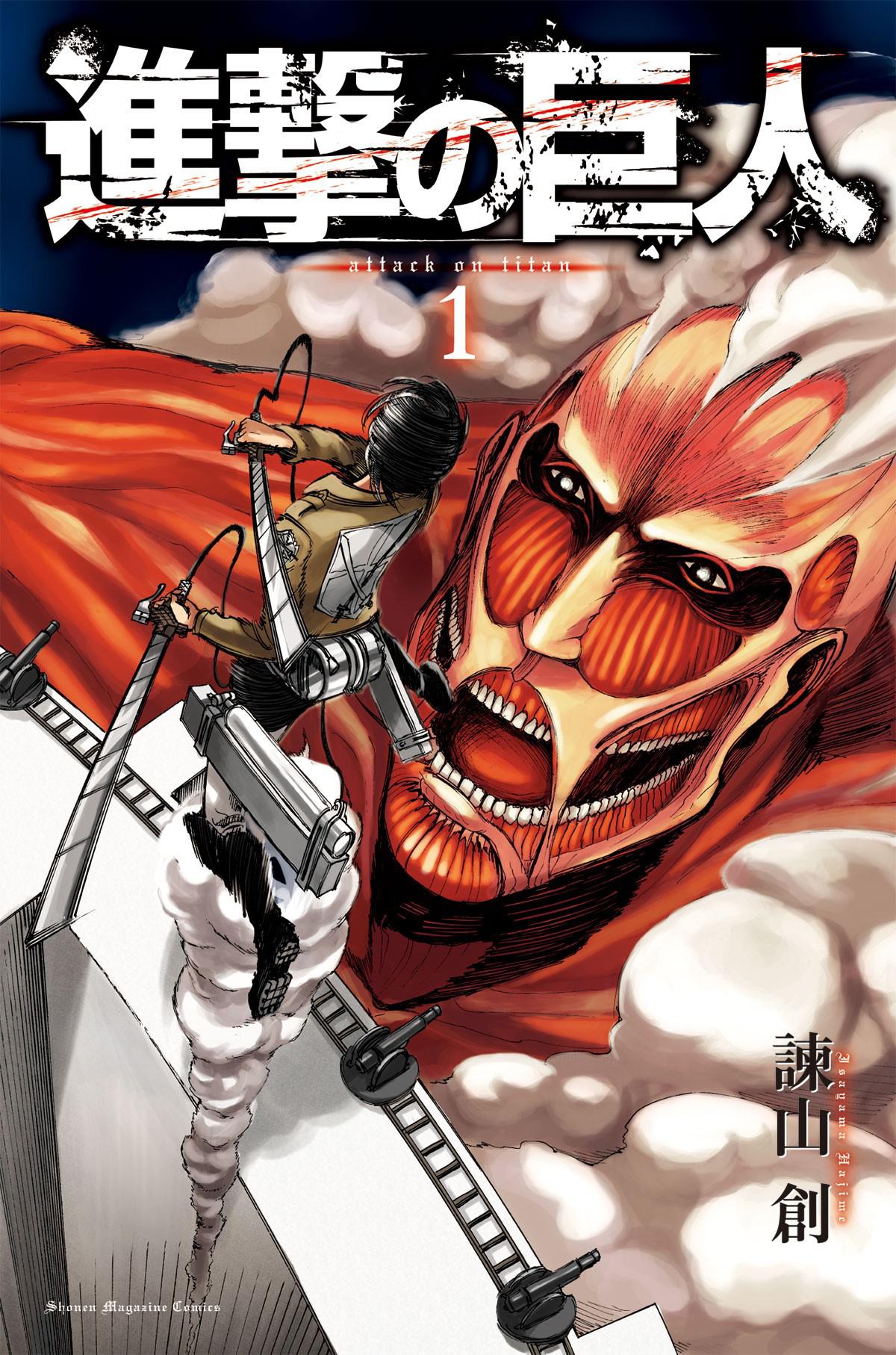
Plot
The original manga is published by one of the largest publishing companies in Japan, the Kodansha Publishing. It counts 21 volumes up to today. It was created by Hajime Isayama and the story, and it takes place in an alternative Midldle Age era. The plot revolves around the character of Eren Jaegar. He lives in a world that many centuries before had been on the verge of destruction. The few humans that survived now live in a urban complex built inside three concentric walls, 50 meters each. The only protection between mankind and the outside world overrun by mysterious creatures are the titans.
This titans resemble human beings but they can be from 3 to 15 meters tall, apparently thoughtless and with the sole objective of devouring human flesh. However, an unexpected event will bring this period of peace to an end. A titan so tall that he could even surpass the walls, appears from nowhere opening a hole in the most external wall. This allowed other titans to break into the city and leading to the massacre of many human lives.
Eren, after regaining his senses because of the loss of his mother by the hands of a titan, swears to eliminate every single titan in the world, and he will not be alone in this fight against the unknown.
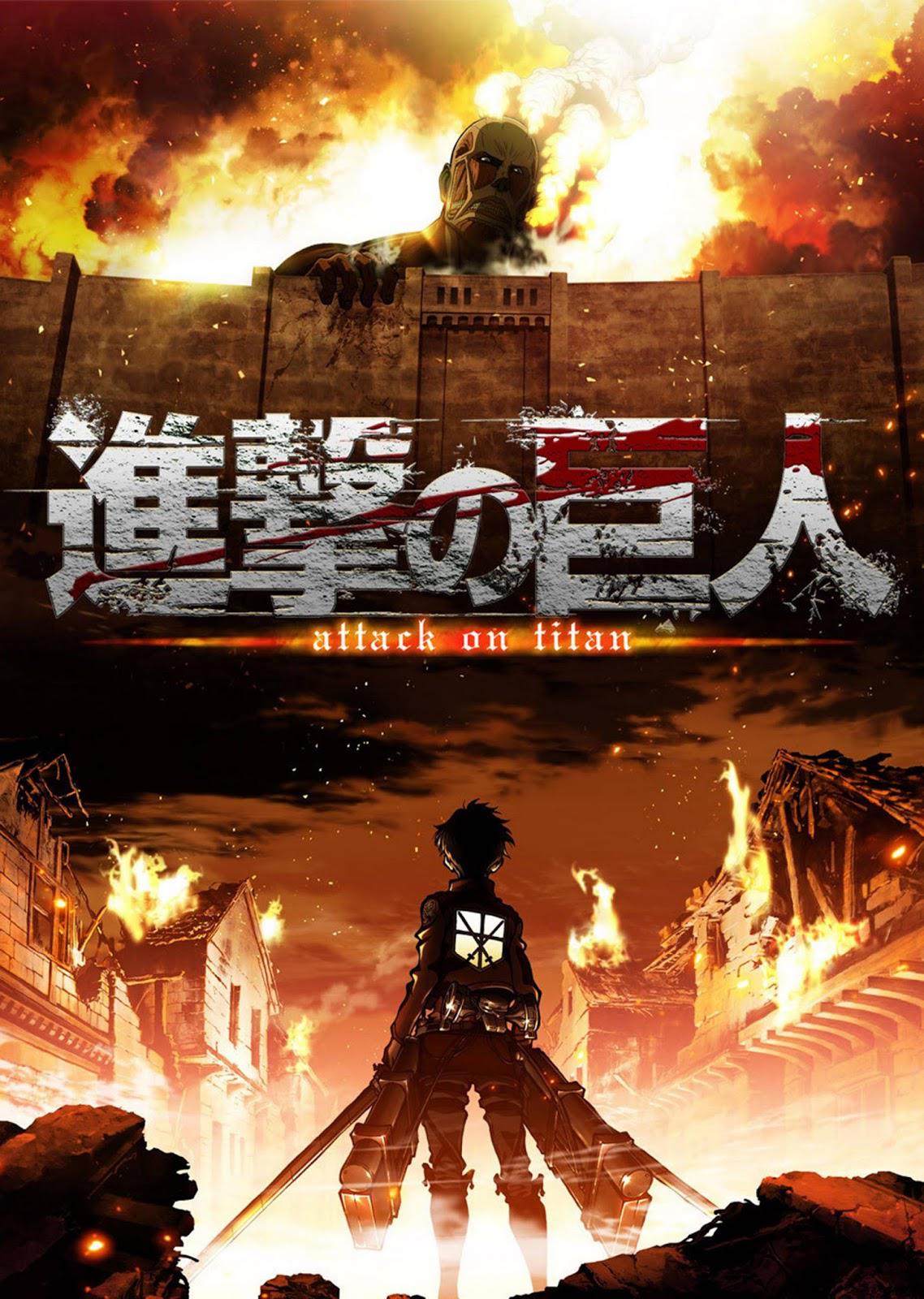
Anime adaptation and international recognition
This series gained its worldwide success thanks to its anime adaptation, produced by Wit Studio in collaboration with the famous Production I.G, that was release in 2013.
The difference with the original panels of Isayama in terms of visual impact is astonishing: with an incredible attention to even the smallest detail, and animated by an extremely realistic animation, all the characters take their actions on a background equally elaborated and realistic. The producers of the animated series filled the holes in terms of style left by the mangaka. He also followed the whole production, giving advice on which was the best way to give shape to his ideas.
The original soundtrack skillfully created follows the whole narration. It never fall silent, it never leaves open spots. Instead, it contributes to underline every instant of the story and envelopes the viewer in an action anime full of twists and turns.
Action, horror elements, political intrigues, religious fanaticism and the fight for survival create the background. Here well delineated characters take their action, in a crescendo of action and suspense, showing us both the strength and fragility of human beings.
Nothing has been left to chance. Even characters that apparently look not so important will be proven to have a fundamental role to play.
The horror element is skillfully balanced, it doesn't exceed into pure violence, searching for the smallest gory detail. All this makes the animated version even more enjoyable and appropriate even for people who don't really like this genre.
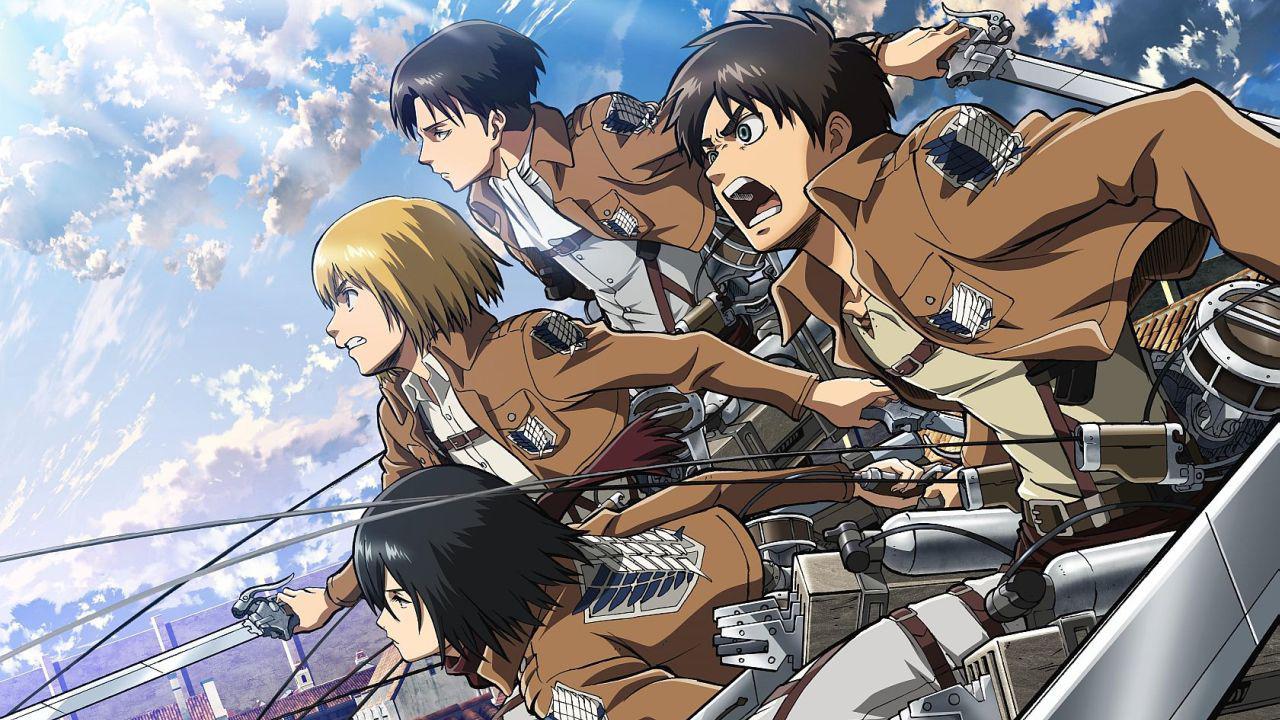
Interpretations
This series is open to many interpretations, someone even wanted to read into it a sort of political propaganda. However, the author himself gave us some keys to understanding the genesis of the story.
For examples, the 3 walls in which mankind survives, can be seen as both a protection and a suffocating prison. This is the exact same feeling that the Isayama experienced living in his hometown in Ōita prefecture surrounded by mountains. And it is clearly visible here a parallelism with Japanese society, generally known to be isolationist and enclosed.
Furthermore, the titans represent the fear of the unknown, an unknown that you can't even communicate with.
At times the story makes you experience a feeling of overwhelming anguish and fear. The same feeling that is so common in our modern society where nothing is what it seems, but all the characters never stop fighting in their quest for truth and freedom.
深い闇を俺は抜け出した。疾風(はやて)みたいに逃げ出した。
Fukai yami wo ore wo nukedashita. Hayate mitai ni nigedashita.
We broke out of the thick darkness. We escaped from what seemed like a hurricane.
生きた屍みたいだった俺達は、壁の外へ。
Ikita shikabane mitai datta oretachi wa, kabe no soto e.
We, who look like living corpses, are going outside the walls.
また会おうぜ、地図にない場所で。
Mata aou ze, chizu ni nai basho de.
Let's meet again, in the unmapped place.The grate escape by Cinema staff – Second ending
What's next?
The plot hides a secret that is still unknown but you might want to know that the original manga has now entered the final arch so, important truths might be unveiled very soon.
In a moment that some would call of stagnation for the Japanese animation, Shingeki no Kyojin was able to impose its originality, and Isayama created a distinctive style of his own. And this originality was rewarded with the great success in terms of fans that it had and that are still increasing.
Moreover, another good news for all affectionate fans that were kept waiting since 2013: after many denial ad postponements, 3 ova, and a lot of patience of the fans, it was finally announced that the first episode of the second season of the anime will be aired on April 1st (April's fool? Doesn't seem to be the case). The wait is over.
[:]









